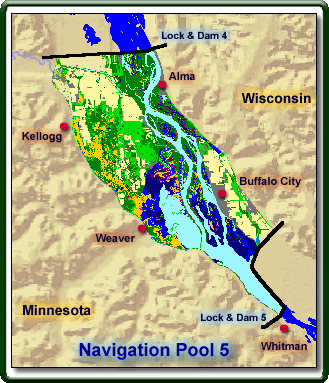- Home
- About S&T
- Taxa/Organisms
- Ecosystems
- Issues
- Methods & Tools
- Reports & Publications
- Location
- Search
Publisher: USGS | Science Center: Upper Midwest Environmental Sciences Center (UMESC, LaCrosse) | Format: URL
www.umesc.usgs.gov — In the Upper Mississippi River, more than 80 species of fish use vegetated habitats during some portion of their life cycle. Fish depend on aquatic vegetation for abundant, high-quality food resources (plant-associated invertebrates) and refuge from predators. Vegetation abundance in the Upper Mississippi River substantially declined in the late More...

Publisher: USGS | Science Center: Columbia Environmental Research Center (CERC, Columbia) | Format: URL
www.cerc.usgs.gov — The BFRS works cooperatively with team members from CERC and with faculty and graduate students of Department of Wildlife and Fisheries Sciences at Texas A&M University in research areas represented by the branch structure of the CERC including toxicology, ecology, biochemistry and physiology, environmental chemistry, ecogeography, and information More...

Publisher: USGS | Science Center: Western Fisheries Research Center (WFRC, Seattle) | Format: URL
wfrc.usgs.gov — Mercury contamination from historic gold mining operations is widespread in many rivers, lakes, and reservoirs on the western slopes of the Sierra Nevada. A multidisciplinary investigation by USGS is attempting to better understand mercury dynamics and to identify hot spots within Camp Far West Reservoir in order to determine if remediation More...

Publisher: USGS | Science Center: Upper Midwest Environmental Sciences Center (UMESC, LaCrosse) | Format: URL
www.umesc.usgs.gov — Eurasian Ruffe pose a threat to native fish because they(1) mature quickly, (2) have a high reproductive capacity, and (3) easily adapt to new environments. Ruffe were first detected in western Lake Superior in 1986. UMESC scientists are conducting research on various types of piscicides (chemicals that kill fish). They are attempting to develop More...

Publisher: USGS | Science Center: Upper Midwest Environmental Sciences Center (UMESC, LaCrosse) | Format: URL
www.umesc.usgs.gov — Zebra mussels have caused drastic declines in native clam and mussel populations in some locations. Zebra mussels compete with other invertebrates and young fish for plankton, the primary food source for these groups. UMESC scientists are investigating the effects zebra mussels are having on the riverine ecosystem. This study examines the effects More...

Publisher: USGS | Science Center: Western Fisheries Research Center (WFRC, Seattle) | Format: URL
wfrc.usgs.gov — Bull trout in the western United States are now listed as threatened under the Endangered Species Act. One cause of bull trout population declines is fish passage issues caused by dams and diversion structures. In order to best design or modify culverts and other fish passage structures in watersheds where bull trout are present, baseline swimming More...

Publisher: USGS | Science Center: Upper Midwest Environmental Sciences Center (UMESC, LaCrosse) | Format: URL
www.umesc.usgs.gov — The Upper Mississippi River System has been highly modified for human use since the late 1800s. One effect of these modifications is that many side channels and backwaters are slowly filling with sediment. The Finger Lakes area of the Upper Mississippi River is a system of six connected backwater lakes just below Dam 4 near Kellogg, Minnesota. More...

Publisher: USGS | Science Center: Western Fisheries Research Center (WFRC, Seattle) | Format: URL
wfrc.usgs.gov — As anadromous juvenile salmonids migrate from freshwater rearing habitats to the ocean, they are vulnerable to a host of factors that affect their survival. Direct effects associated with dam passage (e.g., instantaneous mortality, injury, loss of equilibrium, etc.) and indirect effects (e.g., predation, disease, and physiological stress) More...

Publisher: USGS | Science Center: Western Fisheries Research Center (WFRC, Seattle) | Format: URL
wfrc.usgs.gov — As anadromous juvenile salmonids migrate from freshwater rearing habitats to the ocean, they are vulnerable to a host of factors that affect their survival. Direct effects associated with dam passage (e.g., instantaneous mortality, injury, loss of equilibrium, etc.) and indirect effects (e.g., predation, disease, and physiological stress) More...

Publisher: USGS | Science Center: Western Fisheries Research Center (WFRC, Seattle) | Format: URL
wfrc.usgs.gov — This issue overview addresses the concerns of aquatic community dynamics in Bonneville Reservoir, Columbia River and Tributary Streams, which have been affected by a combination of hydropower development, species introductions and invasions, over-harvest, and habitat degradation in tributaries from agricultural practices. The nature of these More...

Publisher: USGS | Science Center: Western Fisheries Research Center (WFRC, Seattle) | Format: URL
wfrc.usgs.gov — Severe water quality problems in Upper Klamath Lake, OR have led to concerns about how Lost River and shortnose suckers are distributed during the summer and whether suckers utilize areas of water quality refuge. In 2002, the USGS initiated a joint study between the Klamath Falls Field Station and the Oregon District, Water Resources Office to More...

Publisher: USGS | Science Center: Western Fisheries Research Center (WFRC, Seattle) | Format: URL
wfrc.usgs.gov — Microhabitat Associations and Management of Population Dynamics studies have remained largely exercises for finding statistical relations and for monitoring. USGS developed a predictive means called Interaction Assessment (INTASS). INTASS depends on satisfying one basic assertion--that expectations of fitness tend toward equality over all occupied More...
